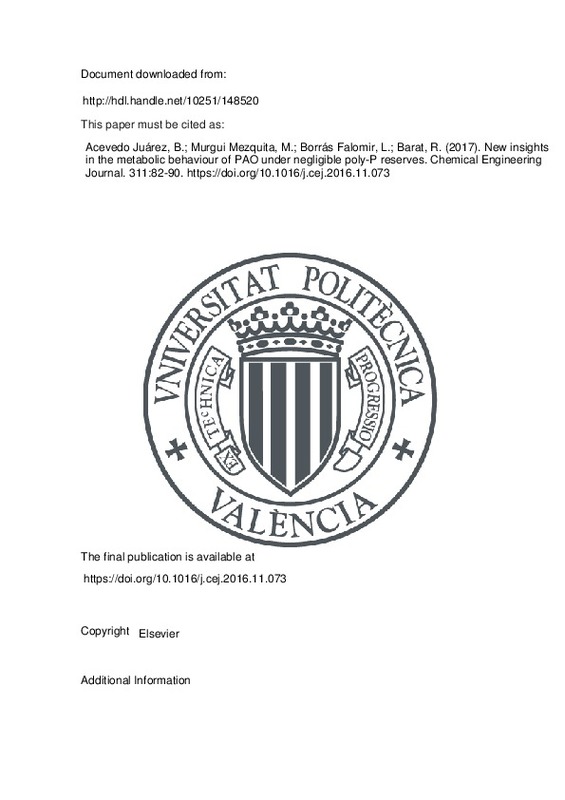JavaScript is disabled for your browser. Some features of this site may not work without it.
Buscar en RiuNet
Listar
Mi cuenta
Estadísticas
Ayuda RiuNet
Admin. UPV
New insights in the metabolic behaviour of PAO under negligible poly-P reserves
Mostrar el registro sencillo del ítem
Ficheros en el ítem
| dc.contributor.author | Acevedo Juárez, Brenda
|
es_ES |
| dc.contributor.author | Murgui Mezquita, Mónica
|
es_ES |
| dc.contributor.author | Borrás Falomir, Luis
|
es_ES |
| dc.contributor.author | Barat, Ramón
|
es_ES |
| dc.date.accessioned | 2020-07-23T03:31:16Z | |
| dc.date.available | 2020-07-23T03:31:16Z | |
| dc.date.issued | 2017-03-01 | es_ES |
| dc.identifier.issn | 1385-8947 | es_ES |
| dc.identifier.uri | http://hdl.handle.net/10251/148520 | |
| dc.description.abstract | [EN] In a previous study the authors confirmed the ability of PAOs to perform GAO metabolism in short-term experiments. However, what happens when PAOs are exposed to poly-P shortage for an extended period of time? The answer to this question was the aim of this work from a macroscopic and microscopic point of view. Therefore, the poly-P was removed from a PAO enriched SBR and maintained without poly-P during five solid retention time. The PAOs were found to quickly change their metabolism to a clear GAO performance and remained without GAO colonization for the entire experimental period, even though GAO was present (around 5%) at the beginning of the experiment. Unlike the results obtained in the short-term experiments, in this case PAO Type I performed the GAO metabolism at the end of the experimental period. (C) 2016 Elsevier B.V. All rights reserved. | es_ES |
| dc.description.sponsorship | This research work has been supported by the Generalitat Valenciana (GVPRE/2008/044) and the Polytechnic University of Valencia (PAID-06-08-3227), which are gratefully acknowledged. Special acknowledgements to the Consejo Nacional de Ciencia y Tecnologia de Mexico (CONACYT) No. 207966. | es_ES |
| dc.language | Inglés | es_ES |
| dc.publisher | Elsevier | es_ES |
| dc.relation.ispartof | Chemical Engineering Journal | es_ES |
| dc.rights | Reconocimiento - No comercial - Sin obra derivada (by-nc-nd) | es_ES |
| dc.subject | Polyphosphate accumulating metabolism (PAM) | es_ES |
| dc.subject | Glycogen accumulating metabolism (GAM) | es_ES |
| dc.subject | Enhanced biological phosphorus removal (EBPR) | es_ES |
| dc.subject | PAO Type I | es_ES |
| dc.subject | PAO Type II | es_ES |
| dc.subject.classification | TECNOLOGIA DEL MEDIO AMBIENTE | es_ES |
| dc.title | New insights in the metabolic behaviour of PAO under negligible poly-P reserves | es_ES |
| dc.type | Artículo | es_ES |
| dc.identifier.doi | 10.1016/j.cej.2016.11.073 | es_ES |
| dc.relation.projectID | info:eu-repo/grantAgreement/CONACyT//207966/ | es_ES |
| dc.relation.projectID | info:eu-repo/grantAgreement/GVA//GVPRE%2F2008%2F044/ | es_ES |
| dc.relation.projectID | info:eu-repo/grantAgreement/UPV//PAID-06-08-3227/ | es_ES |
| dc.rights.accessRights | Abierto | es_ES |
| dc.contributor.affiliation | Universitat Politècnica de València. Departamento de Ingeniería Hidráulica y Medio Ambiente - Departament d'Enginyeria Hidràulica i Medi Ambient | es_ES |
| dc.contributor.affiliation | Universitat Politècnica de València. Instituto Universitario de Ingeniería del Agua y del Medio Ambiente - Institut Universitari d'Enginyeria de l'Aigua i Medi Ambient | es_ES |
| dc.description.bibliographicCitation | Acevedo Juárez, B.; Murgui Mezquita, M.; Borrás Falomir, L.; Barat, R. (2017). New insights in the metabolic behaviour of PAO under negligible poly-P reserves. Chemical Engineering Journal. 311:82-90. https://doi.org/10.1016/j.cej.2016.11.073 | es_ES |
| dc.description.accrualMethod | S | es_ES |
| dc.relation.publisherversion | https://doi.org/10.1016/j.cej.2016.11.073 | es_ES |
| dc.description.upvformatpinicio | 82 | es_ES |
| dc.description.upvformatpfin | 90 | es_ES |
| dc.type.version | info:eu-repo/semantics/publishedVersion | es_ES |
| dc.description.volume | 311 | es_ES |
| dc.relation.pasarela | S\321437 | es_ES |
| dc.contributor.funder | Generalitat Valenciana | es_ES |
| dc.contributor.funder | Universitat Politècnica de València | es_ES |
| dc.contributor.funder | Consejo Nacional de Ciencia y Tecnología, México | es_ES |







![[Cerrado]](/themes/UPV/images/candado.png)

